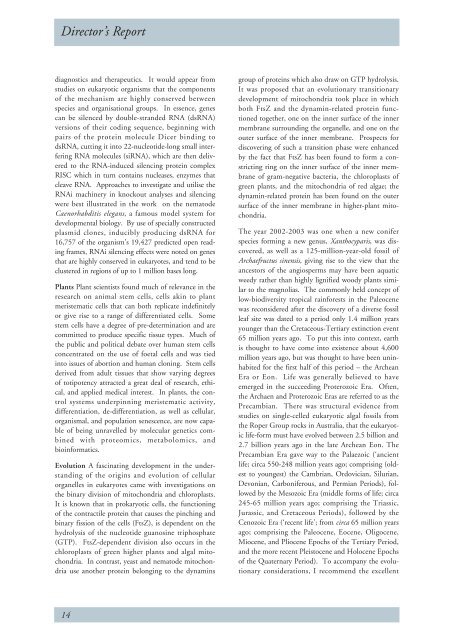PDF file: Annual Report 2002/2003 - Scottish Crop Research Institute
PDF file: Annual Report 2002/2003 - Scottish Crop Research Institute
PDF file: Annual Report 2002/2003 - Scottish Crop Research Institute
Create successful ePaper yourself
Turn your PDF publications into a flip-book with our unique Google optimized e-Paper software.
Director’s <strong>Report</strong><br />
diagnostics and therapeutics. It would appear from<br />
studies on eukaryotic organisms that the components<br />
of the mechanism are highly conserved between<br />
species and organisational groups. In essence, genes<br />
can be silenced by double-stranded RNA (dsRNA)<br />
versions of their coding sequence, beginning with<br />
pairs of the protein molecule Dicer binding to<br />
dsRNA, cutting it into 22-nucleotide-long small interfering<br />
RNA molecules (siRNA), which are then delivered<br />
to the RNA-induced silencing protein complex<br />
RISC which in turn contains nucleases, enzymes that<br />
cleave RNA. Approaches to investigate and utilise the<br />
RNAi machinery in knockout analyses and silencing<br />
were best illustrated in the work on the nematode<br />
Caenorhabditis elegans, a famous model system for<br />
developmental biology. By use of specially constructed<br />
plasmid clones, inducibly producing dsRNA for<br />
16,757 of the organism’s 19,427 predicted open reading<br />
frames, RNAi silencing effects were noted on genes<br />
that are highly conserved in eukaryotes, and tend to be<br />
clustered in regions of up to 1 million bases long.<br />
Plants Plant scientists found much of relevance in the<br />
research on animal stem cells, cells akin to plant<br />
meristematic cells that can both replicate indefinitely<br />
or give rise to a range of differentiated cells. Some<br />
stem cells have a degree of pre-determination and are<br />
committed to produce specific tissue types. Much of<br />
the public and political debate over human stem cells<br />
concentrated on the use of foetal cells and was tied<br />
into issues of abortion and human cloning. Stem cells<br />
derived from adult tissues that show varying degrees<br />
of totipotency attracted a great deal of research, ethical,<br />
and applied medical interest. In plants, the control<br />
systems underpinning meristematic activity,<br />
differentiation, de-differentiation, as well as cellular,<br />
organismal, and population senescence, are now capable<br />
of being unravelled by molecular genetics combined<br />
with proteomics, metabolomics, and<br />
bioinformatics.<br />
Evolution A fascinating development in the understanding<br />
of the origins and evolution of cellular<br />
organelles in eukaryotes came with investigations on<br />
the binary division of mitochondria and chloroplasts.<br />
It is known that in prokaryotic cells, the functioning<br />
of the contractile protein that causes the pinching and<br />
binary fission of the cells (FtsZ), is dependent on the<br />
hydrolysis of the nucleotide guanosine triphosphate<br />
(GTP). FtsZ-dependent division also occurs in the<br />
chloroplasts of green higher plants and algal mitochondria.<br />
In contrast, yeast and nematode mitochondria<br />
use another protein belonging to the dynamins<br />
group of proteins which also draw on GTP hydrolysis.<br />
It was proposed that an evolutionary transitionary<br />
development of mitochondria took place in which<br />
both FtsZ and the dynamin-related protein functioned<br />
together, one on the inner surface of the inner<br />
membrane surrounding the organelle, and one on the<br />
outer surface of the inner membrane. Prospects for<br />
discovering of such a transition phase were enhanced<br />
by the fact that FtsZ has been found to form a constricting<br />
ring on the inner surface of the inner membrane<br />
of gram-negative bacteria, the chloroplasts of<br />
green plants, and the mitochondria of red algae; the<br />
dynamin-related protein has been found on the outer<br />
surface of the inner membrane in higher-plant mitochondria.<br />
The year <strong>2002</strong>-<strong>2003</strong> was one when a new conifer<br />
species forming a new genus, Xanthocyparis, was discovered,<br />
as well as a 125-million-year-old fossil of<br />
Archaefructus sinensis, giving rise to the view that the<br />
ancestors of the angiosperms may have been aquatic<br />
weedy rather than highly lignified woody plants similar<br />
to the magnolias. The commonly held concept of<br />
low-biodiversity tropical rainforests in the Paleocene<br />
was reconsidered after the discovery of a diverse fossil<br />
leaf site was dated to a period only 1.4 million years<br />
younger than the Cretaceous-Tertiary extinction event<br />
65 million years ago. To put this into context, earth<br />
is thought to have come into existence about 4,600<br />
million years ago, but was thought to have been uninhabited<br />
for the first half of this period – the Archean<br />
Era or Eon. Life was generally believed to have<br />
emerged in the succeeding Proterozoic Era. Often,<br />
the Archaen and Proterozoic Eras are referred to as the<br />
Precambian. There was structural evidence from<br />
studies on single-celled eukaryotic algal fossils from<br />
the Roper Group rocks in Australia, that the eukaryotic<br />
life-form must have evolved between 2.5 billion and<br />
2.7 billion years ago in the late Archean Eon. The<br />
Precambian Era gave way to the Palaezoic (‘ancient<br />
life; circa 550-248 million years ago; comprising (oldest<br />
to youngest) the Cambrian, Ordovician, Silurian,<br />
Devonian, Carboniferous, and Permian Periods), followed<br />
by the Mesozoic Era (middle forms of life; circa<br />
245-65 million years ago; comprising the Triassic,<br />
Jurassic, and Cretaceous Periods), followed by the<br />
Cenozoic Era (‘recent life’; from circa 65 million years<br />
ago; comprising the Paleocene, Eocene, Oligocene,<br />
Miocene, and Pliocene Epochs of the Tertiary Period,<br />
and the more recent Pleistocene and Holocene Epochs<br />
of the Quaternary Period). To accompany the evolutionary<br />
considerations, I recommend the excellent<br />
14
















